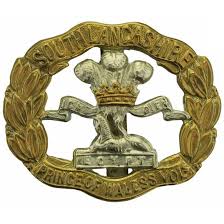Personal Details
Born: 23 August 1892 in Ash, Whitchurch, Shropshire.
Family: He was the youngest of three children born to Thomas Mottram, a gravel getter, and his wife Mary. He married Ethel C Charles in 1917 in Whitchurch; we cannot locate any children for their marriage.
Residence: In 1901 he lived in Vicarage Lane, Ash, Whitchurch. By 1911 the family had moved to 26 Claypit Street, Whitchurch where they were still living in 1919. In 1939 he was living at 20 Bark Hill, Whitchurch.
Employment: He was a general labourer in 1911 and 1939.
Died: In 1969 in Whitchurch.
Military Details
Regiment: South Lancashire Regiment
Rank: Private
Service Number: 31110 (note the 1919 Absent Voters’ Register indicates 30001)
Date of Enlistment: Not known
Date of Discharge: Not known
Reason for Discharge: Not known
Other Information: Brother of Reginald Mottram who also served in WW1.
George was awarded the Campaign Medals (British War Medal, and Victory Medal)

The British War Medal (also known as 'Squeak') was a silver or bronze medal awarded to officers and men of the British and Imperial Forces who either entered a theatre of war or entered service overseas between 5th August 1914 and 11th November 1918 inclusive. This was later extended to services in Russia, Siberia and some other areas in 1919 and 1920. Approximately 6.5 million British War Medals were issued. Approximately 6.4 million of these were the silver versions of this medal. Around 110,000 of a bronze version were issued mainly to Chinese, Maltese and Indian Labour Corps. The front (obv or obverse) of the medal depicts the head of George V. The recipient's service number, rank, name and unit was impressed on the rim.
The Allied Victory Medal (also known as 'Wilfred') was issued by each of the allies. It was decided that each of the allies should each issue their own bronze victory medal with a similar design, similar equivalent wording and identical ribbon. The British medal was designed by W. McMillan. The front depicts a winged classical figure representing victory. Approximately 5.7 million victory medals were issued. Interestingly, eligibility for this medal was more restrictive and not everyone who received the British War Medal ('Squeak') also received the Victory Medal ('Wilfred'). However, in general, all recipients of 'Wilfred' also received 'Squeak' and all recipients of The 1914 Star or The 1914/1915 Star (also known as 'Pip') also received both 'Squeak' and 'Wilfred'. The recipient's service number, rank, name and unit was impressed on the rim.

